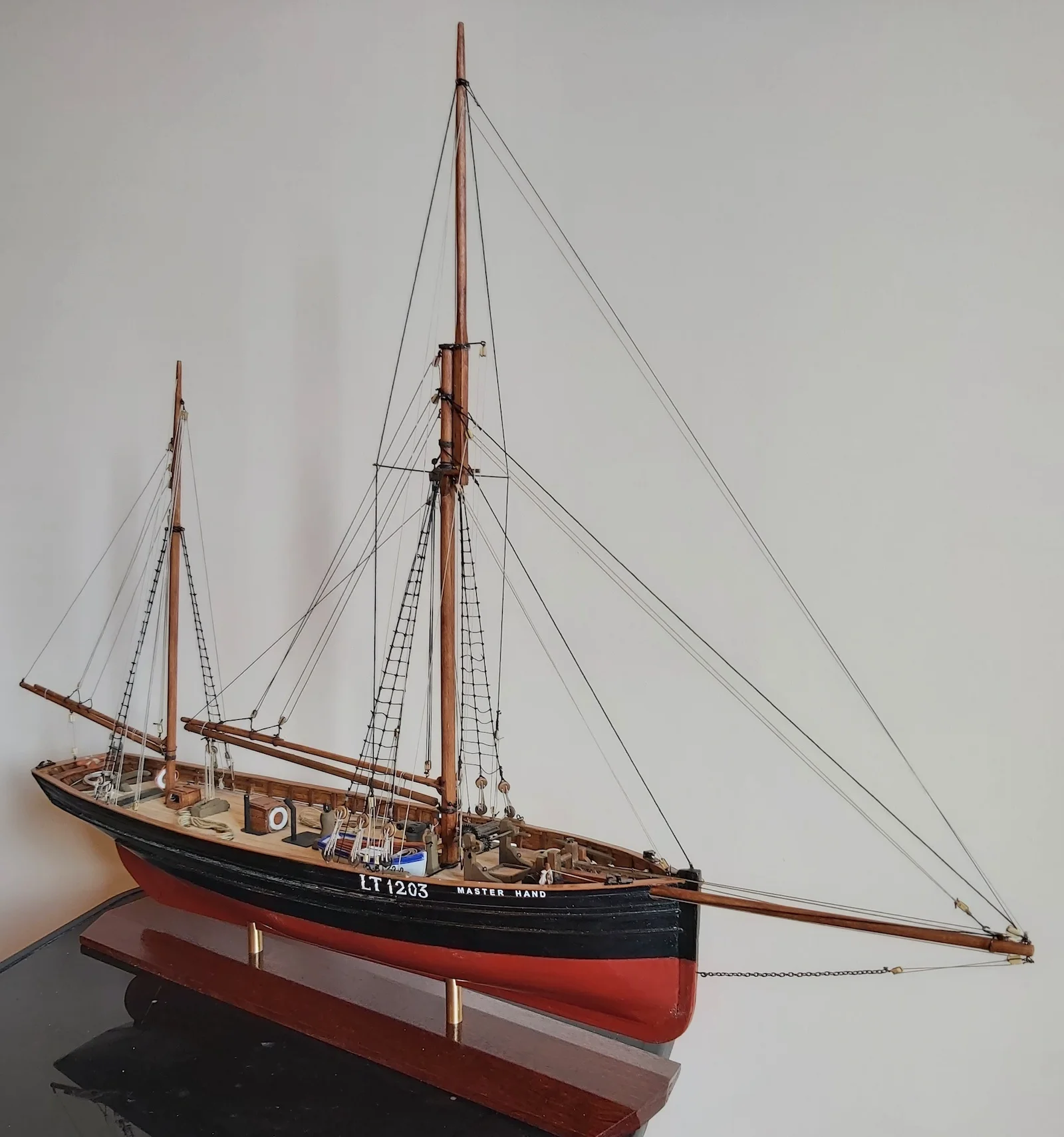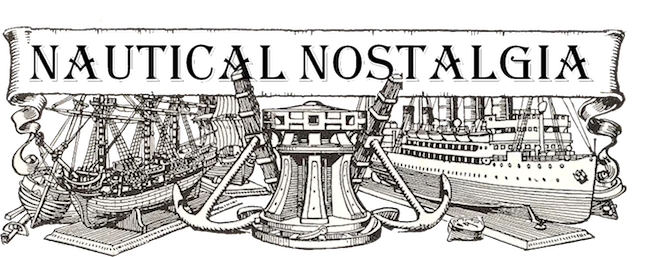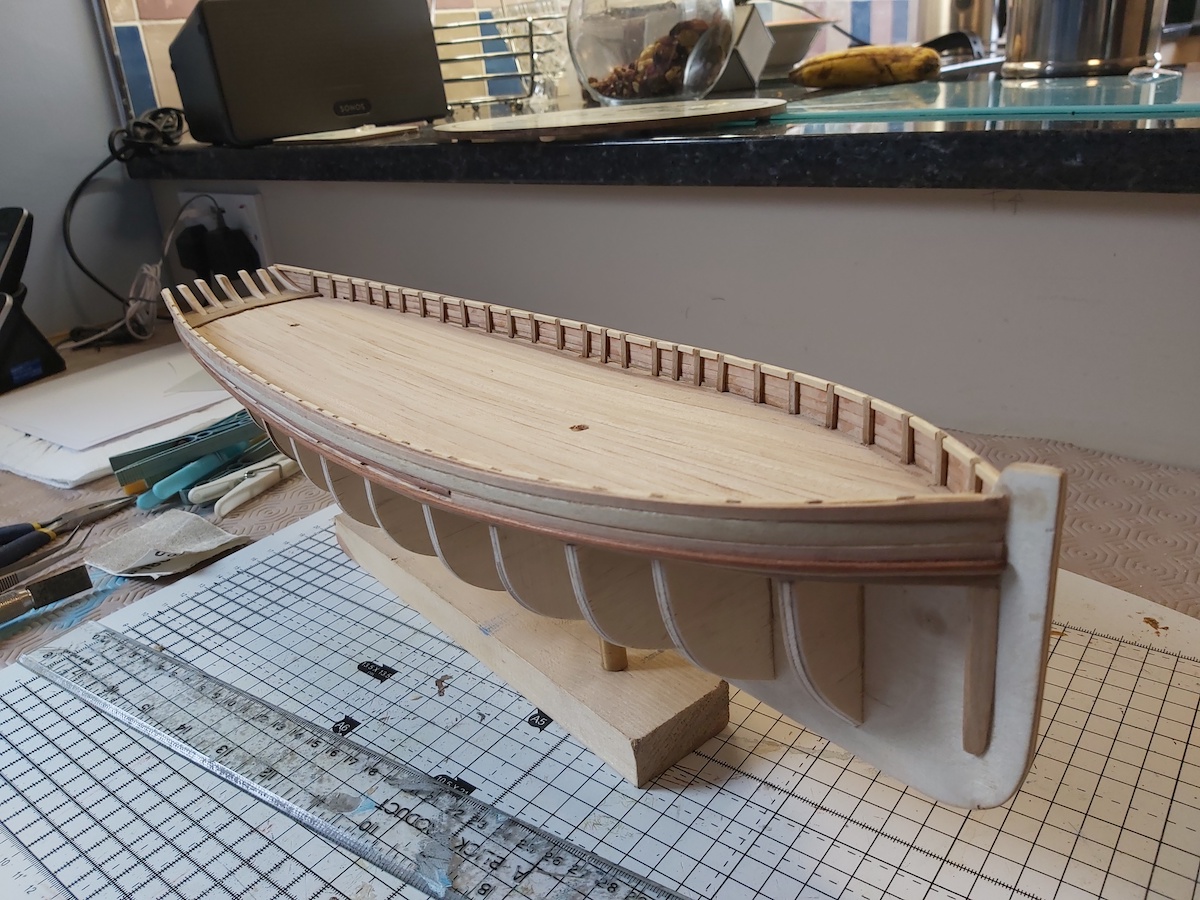Master Hand
In the 1950s marine historian Edgar J March wrote a number of definitive books about local UK sailing vessels, including “Sailing Drifters” and “Sailing Trawlers”. My second-hand copies were acquired when I was a teenager, and these books became very well -thumbed. March described in detail the fishing industry, activities and boats in all the local coastal regions.
Included in the books were many detailed drawings of all the boats described; sail plans, hull lines and deck plans. Many of the drawings were compiled by March after measurement and surveys of the original boats. For those interested in fishing vessels these books are a model-makers heaven.
Back in 1976 I built a model of the Yarmouth lugger “Gypsy Queen”, clinker built. I used limewood for the planking, and ballasted the hull as I intended her to sail on the local pond. She was one of my earliest scale mode-building efforts, and looking at her now she is quite crude. But – she did sail on the pond, after which she became a display model.
When covid arrived, I was looking for a project to occupy my breakfast-bar shipyard, and dug out my copy of ” Sailing Trawlers”. Locally, in Lowestoft, we have the sailing trawler “Excelsior” preserved for posterity in superb condition, and frequently voyaging afar. A very similar smack was surveyed in detail by March, and features prominently in “Sailing Trawlers”.
” Master Hand ” was built in Rye in 1920 by G & T Smith to the order of James Breach and James Goffin. Her skipper was J Crouch. She was a typical smack of the time, and represents the final development of the sailing trawler. In 1946 she was in Claxton’s shipyard in Ramsgate undergoing conversion to motor power. March was allowed full access, and as a result he was able to compile very full and detailed plans of the vessel. In the book are reproduced full hull lines, deck plans, internal arrangements and sail plans. In addition is a very detailed description of every component of the hull and rigging, including many individual detail drawings.
I had been promising myself to build a model of this vessel for many years, and now was the opportunity.
No plans are available commercially, so I had to scan the drawings in the book, and scale up to 1:48 or ¼” to the foot. A keel profile was carefully plotted, and paper templates were made corresponding to the bulkhead stations. Taking great care to ensure accuracy keel and bulkheads were cut out in 3mm ply and slotted together. I have learnt from experience that lack of care and accuracy at this stage invariably results in an un-fair hull with unwanted bulges and hollows. I have built many kits of period sailing vessels, and nowadays we are, of course, used to precision laser-cut components, which simplifies this stage of construction considerably. It was something of a shock to have to go back to the old-fashioned methods!
All the bulkheads were carefully bevelled and triple- checked for alignment before final fitting with glue. I took the opportunity to install my internal fixing arrangements for eventually securing the hull to its stand. This has been described before in this magazine, but briefly, holes are carefully drilled upwards into the keel, intercepting small horizontal slots cut into the keel plate. Two nuts are made from steel, about 10mm square; these are firmly secured in place so that long steel screws threaded 6BA can be inserted from beneath. Brass keel pillars are turned up on the lathe, bored axially, and slotted to fit the keel. This allows a positive mounting onto a baseboard. During construction an odd piece of 2″ x 1″ wood is used as a base. This can be clamped into the vice as needed. All this must be done before the planking, as the interior of the hull becomes inaccessible once the planking is complete.
Planking proceeded. I used two layers of 1mm limewood. All was very straightforward. This type of boat doesn’t have any straight lines in her hull. The ply bulkheads had thin “ears” projecting above deck level to help the location of the bulwarks.
The upper edges of the bulkheads had to be carefully worked to produce the correct deck camber and sheer; any inaccuracies here would be very visible. The stern was a considerable piece of shipwright work with numerous knees and carlins producing the curved counter/transom. The deck was “laid” with a substrate of 0.5mm plasticard, then planked over with lime strips.
The hull planking was continued upwards above the deck line to form the bulwarks. This was an awkward task, as for over half of their length the bulwarks were “floating”, with a gap (around 3″ in the real vessel) between the lower edge of the bulwarks and the deck. This is effectively a continuous “freeing port”, allowing heavy water on deck to clear rapidly in bad weather. Without these freeing ports, a heavy sea breaking aboard could put enough weight of water on deck to capsize the boat.
Planking the bulwarks in the model was guided by the “ears” sticking up from the bulkheads, but these were only temporary. Once the bulwark construction – two layers of planking – was complete the bulkhead ears were removed.
This left the bulwark completely unsupported for over half the length of the vessel amidships. Fortunately they maintained their shape. The bulwark stanchions were then installed at the correct intervals. The bulwark cap rail was then fitted to finish off the hull.
The rudder was made and fitted with the correct arrangement of gudgeon and pintle irons. I didn’t drill for a rudder post; the rudder was fixed in place using horizontal pins fitted fore-and-aft into the rudder and sternpost. Thus the rudder is a non-moving dummy. On deck a dummy rudder post head was fitted carrying the tiller.
March has very helpfully described and illustrated every deck erection and fitting, down to the last detail. One interesting fitment was the steam capstan. Although the smack is a pure sailing vessel, she has a coal-fired donkey boiler generating steam to drive the capstan.
The engineering firm of Elliot and Garrood of Beccles built many of these capstans to their design for both sailing trawlers and steam drifters. Of an ingenious design, the steam supply to the capstan was from beneath the deck, the pipe passing up through the middle of the capstan barrel.
The steam engine driving the capstan was on the top. Elliot and Garrood specialised in machinery for fishing boats. When steam became commonplace, the company perfected the “monkey triple” steam engine for main propulsion. This was a triple-expansion engine in which the high-pressure cylinder was mounted directly above the intermediate-pressure cylinder. The low-pressure cylinder was adjacent. This gave an engine of reduced length so the engineroom could be shorter, allowing more space in the fish hold.
But I digress. Having completed the fitting out of the deck it was time to tackle the masts, spars and rigging. Again, March has provided detailed drawings of every mast and spar, and rigging arrangements.
The mainmast carries a gaff sail, with a topmast above setting a topsail. It was customary to have a “winter topmast” carrying a reduced area of topsail, while a longer “summer topmast” allowed the setting of a huge jackyard topsail. A lengthy bowsprit carried a jib and jib topsail in lighter weather. The mizzen mast is stepped forward of the tiller, setting a gaff sail and topsail. The mizzen mast has a distinct forward rake, looking a little odd to the uninitiated.
Rigging was a straightforward job, and less extensive compared to the square-riggers I have completed in the past. I don’t show sails. I contend that a full-hull static display model should not carry sails. Sails should only be set in a waterline model set in a scenic sea, heeling to the breeze. A suitable baseboard was made and varnished, and keel pillars turned up on the lathe.
All the books by Edgar J March are now out-of-print, so the many drawings and descriptions of many types of vessel are no longer available. This I consider to be something of a tragedy. It is a real pity that these drawings have not been published and included in the offerings of one or other of the model boat plans suppliers. March spent a lifetime researching and recording local craft and vessels; fishing boats and barges. This archive needs to be preserved and made public.

Bibliography:
“Sailing Trawlers” by E J March pub Percival Marshall 1953, second edition 1970
” Sailing Difters” by E J March pub 1952 Percival Marshall
“Spritsail barges of the Thames and Medway” by E J March pub Percival Marshall 1948
“Inshore Craft of Britain” 2 vols by E J March pub Percival Marshall 1970. New edition by Chatham 2005









